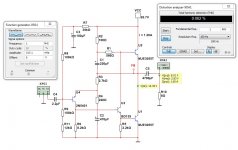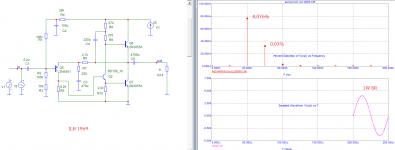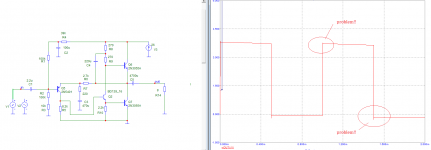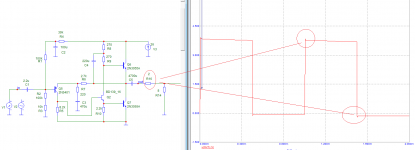JLH 1969 CLASS-A
Although it's not much difficult for me to build a good class-ab amplifier but i always wanted to start my discrete amp journey by building a class-A amplifier. So i made one, a zeroboard/ experimental version of John linsley hood Class-A. I used all cheapo components, so nothing special. For input tr i used 2n3906, for driver/phase splitter old faithful bd139 (sorted for higher gain) & for outputs venerable 2n3055 as sacrificial rat
For capacitors 0.47uf mkt as input, 470uf for bootstrap+feedback and 3300uf as output cap. For power supply i used a 125va transformer with 17vAC secondary(34vCT), a CRC filter made of 4×4700uf & 0.33R 5W wirewound resistor and for rectification 6A6 type discrete diodes.
Supply voltage(unloaded)--22vDC
Supply voltage(loaded)--19vDC
Quiescent current--1.1ampere
The result is impressive, i mean i like the sound. Probably the distinction isn't hugh in comparison with lm3886 but there a 'difference'! I mean very revealing sonic qualities, excellent midrange. I don't know why some people say this amp isn't good at low end(uncontrolled bass etc), this is totally false. With little bass boost it sounds really amazing. But one thing i want to mention that this amplifier is quite sensitive to radio frequencies. Although there is no noise at all when input disconnected.
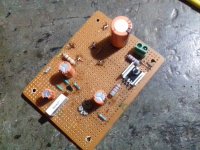
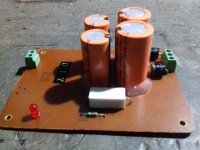
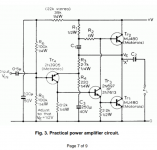
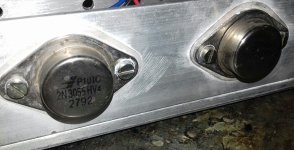
Last edited:
Now you are ready to build some real amplifiers, like those from Mr. Nelson.
You will be surprised, but this amplifier really sounds bad, for the following reasons:JLH 1969 CLASS-A
The result is impressive, i mean i like the sound. Probably the distinction isn't hugh in comparison with lm3886 but there a 'difference'! I mean very revealing sonic qualities, excellent midrange. I don't know why some people say this amp isn't good at low end(uncontrolled bass etc), this is totally false. With little bass boost it sounds really amazing. But one thing i want to mention that this amplifier is quite sensitive to radio frequencies. Although there is no noise at all when input disconnected.
View attachment 1077131View attachment 1077133View attachment 1077134
View attachment 1077132
1. quality depends on capacitors C3 and especially C2
2. Also, distortion from the output is again fed to the input of the output stage through the capacitor C1
3. T4 gain is not enough for the quality of the negative feedback
4. at a load of 4 ohms, the shape of the transient characteristic is greatly distorted, and the fronts themselves are not symmetrical initially.
P.S. The value of the input capacitor also matters, if it is more than 0.68 uF, the phase characteristics at low frequencies transform into bizarre shapes when the phase derivative changes sign within one sound octave. It's an exciter audio, not an amp...
P.S. 2. You used vintage 3055 - that's good, because if you apply something better and more modern, you will need additional correction ....
Last edited:
Can you see the same idea here:
https://sound-au.com/p36-fig4.gif
It is the 'Death of Zen' amplifier by Rod Elliott.
I bet this amplifier is better than JLH 10 Watt.
https://sound-au.com/p36-fig4.gif
It is the 'Death of Zen' amplifier by Rod Elliott.
I bet this amplifier is better than JLH 10 Watt.
@Hennady Kovalsky
Hello, this is my first Class-A so i don't know much about them(Sonic qualities etc). I intentionally used low value cap for input and output because i heard that this amp has problem at very low frequencies. Probably that's why my jlh sounds good! Although i used cheap carbon film resistors but the quality of the capacitors are not bad(Keltron India). Also i didn't use any counterfeit components. Btw i'm using 8ohm FR spkrs.
Hello, this is my first Class-A so i don't know much about them(Sonic qualities etc). I intentionally used low value cap for input and output because i heard that this amp has problem at very low frequencies. Probably that's why my jlh sounds good! Although i used cheap carbon film resistors but the quality of the capacitors are not bad(Keltron India). Also i didn't use any counterfeit components. Btw i'm using 8ohm FR spkrs.
Last edited:
Coincidence? Yes, DOZ going to be my next Class-A amp🙂 I'll be back soon.Can you see the same idea here:
https://sound-au.com/p36-fig4.gif
It is the 'Death of Zen' amplifier by Rod Elliott.
I bet this amplifier is better than JLH 10 Watt.
Well, THD 0.062% like in JLH 10W, is probably too little to be heard.
So, there is nothing really wrong with that amplifier.
DOZ is probably little less THD than JLH.
But both amplifiers has much more THD than Blameless amplifiers.
Again, an amplifier with THD 0.062% THD can most certain sound as good.
So, there is nothing really wrong with that amplifier.
DOZ is probably little less THD than JLH.
But both amplifiers has much more THD than Blameless amplifiers.
Again, an amplifier with THD 0.062% THD can most certain sound as good.
Actually it's not always about vanishing thd or such. I just want listen good music, that's all. As far as i know human ear can't detect thd <0.1%, in most cases. Anyway it's nice to have you here Mr.lineup 🙂
Я установил оригинальный JLH класса A 10 Вт в свой SPICE.
Искажения довольно высокие по сравнению, например, с Doug Self Blameless.
Я попробую настроить JLH 10 Вт.
Может быть, я вернусь с каким-то результатом.
ок, вы использовали входное амплитудное напряжение на частоте 1 кГц 0,316мВ, что соответствует выходному напряжению СКЗ от источника 220мВ (современные источники имеют гораздо большее выходное напряжение), а выходная мощность при этом будет 0,98 Вт при нагрузке 8 Ом.
смотрим спектр гармоник на этом 1 ватте выходной мощности,
несколько уточнений на выходе из стартовой темы есть 2H3055, которым нужен больший ток драйвера, чем MJE3055 и сопротивление в нагрузке драйвера должно быть равно R8=R9 (см. мое вложение), для большей эффективности бустера и меньше влияет на звук.
Attachments
Last edited:
When connecting a real speaker system, problems begin in the transient response, the simplest solution is to additionally connect a 2ohm 50 watt resistor (P16 in the diagram) in series with the load. in this case there is no problem.
Attachments
The human ear does not hear the distortion of only the first two harmonics no more than 0.04%, however, it is very sensitive to the distortion of higher harmonics even if their level is 0.01%. The best indicator is the fronts of transient responses.Actually it's not always about vanishing thd or such. I just want listen good music, that's all. As far as i know human ear can't detect thd <0.1%, in most cases. Anyway it's nice to have you here Mr.lineup 🙂
In Rod Eliott's version, the driver transistor has more current, due to which there is no odd 3rd harmonic in the distortion spectrum.Can you see the same idea here:
https://sound-au.com/p36-fig4.gif
It is the 'Death of Zen' amplifier by Rod Elliott.
I bet this amplifier is better than JLH 10 Watt.
JLH used his amplifier with a speaker at 15 ohms. Modifications with Mosfet or Darlington can work with a load of 4 ohms and in class AB.
In class A, there is an optimal match between the supply voltage, the quiescent current of the output stage and the load resistance.
https://www.diyaudio.com/community/threads/jlh-10-watt-class-a-amplifier.3075/page-420
#8363
In class A, there is an optimal match between the supply voltage, the quiescent current of the output stage and the load resistance.
https://www.diyaudio.com/community/threads/jlh-10-watt-class-a-amplifier.3075/page-420
#8363
Last edited:
Mosfet is not suitable, because there is no base current for the correct operation of the driver. Dalingtons are good.
Nonsense what you tell, Linsly Hood is totally different amp like Neslon Pass 😀,Linsly Hood ist Good ,NP ist Good .Now you are ready to build some real amplifiers, like those from Mr. Nelson.
this option will be better than the original, because. reduced sensitivity, boosttrap capacitor C6 connected to the high impedance point of the output transistors, but i think the correction is not quite optimal, since the frequency response pole oupen loop is reduced to 15kHz (C5 correction has very large capacity).......#8363
also Q1 and Q3 need to be made more linear by adding resistors to the emitters.
it is also desirable to add the Zobel chain.
Last edited:
- Home
- Amplifiers
- Solid State
- My first discrete amp build
